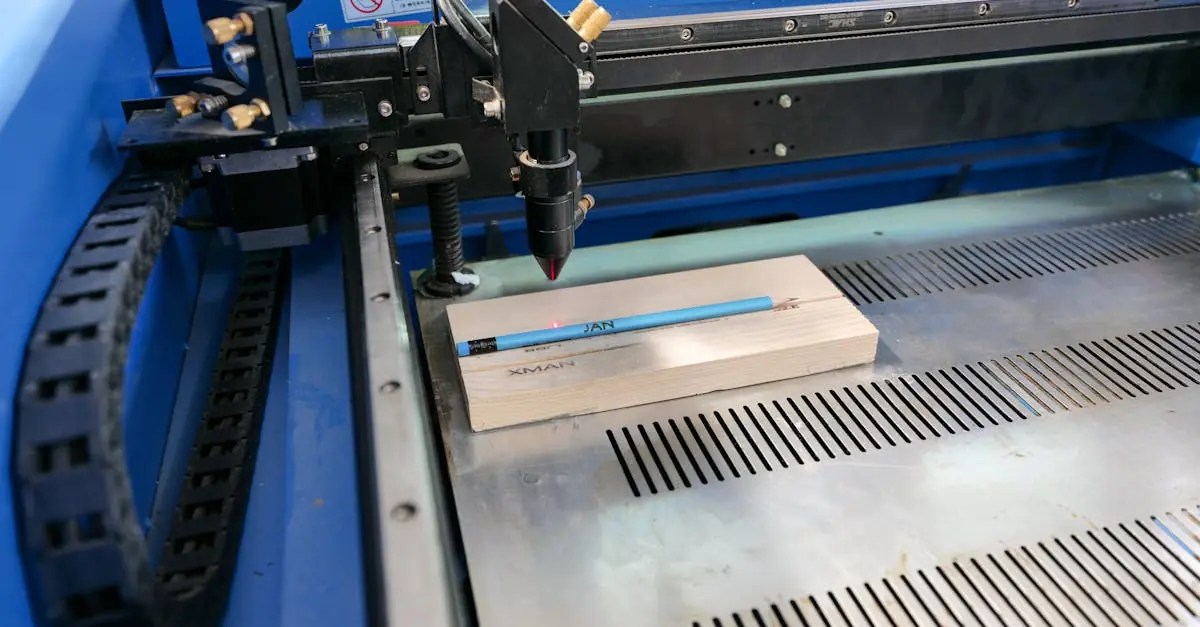In a world where time is money and precision is king, automation CNC machines and robotics are the unsung heroes of modern manufacturing. Imagine a factory floor where machines work tirelessly, never complain about overtime, and don’t need coffee breaks. Sounds like a dream, right? Well, it’s a reality that’s reshaping industries and boosting productivity like never before.
Table of Contents
ToggleOverview of Automation CNC Machines and Robotics
Automation in manufacturing significantly relies on CNC machines and robotics. These technologies streamline production processes, resulting in increased efficiency. With CNC machines, precision cutting and shaping of materials occurs, minimizing human error. Various industries, from aerospace to automotive, leverage these machines for high-quality components.
Robotics complements CNC technology by handling repetitive tasks, reducing labor costs, and improving workplace safety. Robotic arms can manage assembly, packing, and inspections swiftly and accurately. As a result, manufacturers gain the capacity to scale operations without compromising quality.
Data from a report by MarketsandMarkets indicates that the global CNC machine market is expected to reach $100 billion by 2026, driven by the need for automation. A rise in demand for custom parts fuels this growth, placing CNC machines at the forefront of manufacturing innovation.
Integration of robotics with CNC technology enhances operational workflows. Robots provide flexibility in production lines, easily adapting to different tasks or product specifications. Moreover, advancements in software enable better programming and real-time monitoring of machine performance.
Collaboration between robots and CNC machines fosters smart manufacturing. This approach promotes a smarter supply chain through improved data exchange and analytics. Companies investing in automation technologies report significant reductions in production times and operational costs.
Together, automation, CNC machines, and robotics reshape production landscapes, ensuring competitiveness in a dynamic market. These innovations mark a crucial advancement in operational excellence, positioning businesses for future growth and success.
Benefits of Automation CNC Machines
Automation CNC machines offer numerous advantages that significantly impact manufacturing processes. Enhanced operational capabilities lead to greater productivity and competitiveness.
Increased Efficiency
Increased efficiency results from the continuous operation of automation CNC machines. These machines work around the clock, eliminating downtime associated with human labor. Quick setup times enable faster transition between tasks, ensuring smoother workflows. Automation reduces cycle times while maintaining consistent output levels. Reports indicate that manufacturers experience up to a 30% increase in production speeds when utilizing CNC technology. Additionally, machines can operate with minimal supervision, allowing human workers to focus on more complex tasks, further optimizing overall efficiency.
Improved Precision
Improved precision is another key benefit of automation CNC machines. These machines execute tasks with exceptional accuracy, often within ±0.005 inches, ensuring high-quality output. Consistent results reduce waste by minimizing errors in production. Manufacturers in industries such as aerospace and automotive rely on this level of precision for critical components. Implementation of CNC technology can lead to a 20% reduction in material waste, enhancing cost-effectiveness. High-quality parts produced with precision also contribute to better product performance and reliability, solidifying a company’s reputation in the market.
Types of CNC Machines
CNC machines come in various types, each serving specific applications in manufacturing. Understanding these types helps in selecting the right machine for particular tasks.
Milling Machines
Milling machines form a vital part of CNC technology. These machines remove material from a workpiece using rotational cutting tools. They can produce complex shapes with high precision. Various industries rely on milling machines due to their versatility, which allows them to create intricate components like gears and brackets. Enhanced with computer control, modern milling machines operate automatically, leading to efficient processing with minimized human intervention.
Lathes
Lathes are essential CNC machines that shape material by rotating the workpiece against a stationary cutting tool. This process creates cylindrical parts such as shafts and bolts with exceptional accuracy. The integration of CNC technology in lathes enhances their capability to execute complex designs seamlessly. Operators can program these machines to perform multiple tasks, reducing setup times and improving productivity. As a result, lathes play a significant role in industries demanding high-quality finished products.
Integration of Robotics in CNC Automation
Robotics enhances CNC automation, significantly transforming manufacturing processes. The use of robotic arms in conjunction with CNC machines allows for precise handling of components, improving efficiency.
Robotic Arms
Robotic arms perform tasks like material loading and unloading, which reduces human intervention. They excel in repetitive actions, ensuring consistent quality across production runs. These robotic systems function seamlessly with CNC machines to maintain high throughput. Integrating robotic arms into CNC setups can lead to a 20% reduction in cycle times, allowing manufacturers to respond rapidly to market demands. Enhanced safety measures come from minimizing human exposure to hazardous environments. Manufacturers often see significant returns on investment thanks to increased productivity and reduced labor costs.
Collaborative Robots
Collaborative robots, or cobots, work alongside human operators safely and efficiently. Designed to assist in various tasks, they allow for more flexibility in manufacturing workflows. Combining cobots with CNC machines encourages a smart manufacturing environment, where operators and robots communicate in real-time. These robots adapt easily to varying production requirements and can operate without safety cages. With rapid deployment and minimal programming, they help manufacturers achieve higher operational efficiency. Reports suggest the adoption of collaborative robots can enhance productivity by up to 30% while improving overall worker satisfaction and safety in the workplace.
Challenges in Implementing Automation
Implementing automation through CNC machines and robotics presents several challenges that organizations must navigate.
Initial Costs
Initial costs of automation can be substantial. Companies face significant expenditures when acquiring CNC machines and robotics systems. Investments include not just the equipment itself but also installation, programming, and maintenance expenses. For instance, the average price for a CNC machine ranges from $30,000 to over $500,000 depending on functionality and size. Organizations often experience budget constraints, particularly small manufacturers who may find it difficult to justify such investments. Long-term savings don’t always offset upfront expenses, complicating decision-making processes. Financing options exist, but they can introduce additional complexities into financial planning.
Technical Challenges
Technical challenges often arise during automation integration. Machine compatibility with existing production systems can hinder smooth transitions. Training workers on new technologies also poses significant hurdles, as they may lack the necessary skills to operate advanced CNC machines and robotics systems effectively. A report by MarketsandMarkets highlights that about 26% of manufacturers cite a skills gap as a barrier to adopting automation technologies. Moreover, process optimization requires time and expertise to fully leverage capabilities of the new systems, adding to the complexity of implementation. Troubleshooting unexpected technical issues often delays production, impacting overall efficiency.
Future Trends in Automation CNC Machines and Robotics
The landscape of automation in CNC machines and robotics continues to evolve. Innovations shape manufacturing processes, enhance efficiency, and redefine capabilities.
Advancements in Technology
Emerging technologies drive advancements in CNC automation and robotics. Artificial intelligence plays a significant role in optimizing machining processes, allowing for self-adjusting parameters and predictive maintenance. Machine learning algorithms analyze vast amounts of data, improving operational efficiency. Additive manufacturing expands CNC capabilities, enabling production of complex components with minimal waste. The development of smart sensors leads to real-time monitoring of machine performance, ensuring consistent quality. These advancements boost productivity by decreasing downtime and improving precision.
Impact on Workforce
Automation reshapes the workforce involved in manufacturing. As CNC machines and robotics become more prevalent, skilled labor requirements shift. Workers must adapt by acquiring new technical skills, focusing on programming and maintenance of advanced machinery. Collaboration between humans and robots increases workplace safety and satisfaction. With robots handling repetitive tasks, employees can engage in more value-added activities. This shift may create new job opportunities in programming, robotics, and system management while reducing the overall demand for low-skilled labor. Organizations must prioritize training programs to help employees transition into these emerging roles.
Automation through CNC machines and robotics is revolutionizing the manufacturing sector. These technologies not only enhance productivity but also elevate precision and safety in production processes. As industries continue to embrace automation, the need for skilled labor is shifting, creating new opportunities for workers to grow in technical roles.
While challenges like initial costs and integration hurdles exist, the long-term benefits far outweigh these obstacles. The future of manufacturing lies in the seamless collaboration between humans and machines. Investing in automation is essential for companies aiming to thrive in an increasingly competitive landscape. Embracing these advancements will ensure operational excellence and pave the way for sustainable growth.



